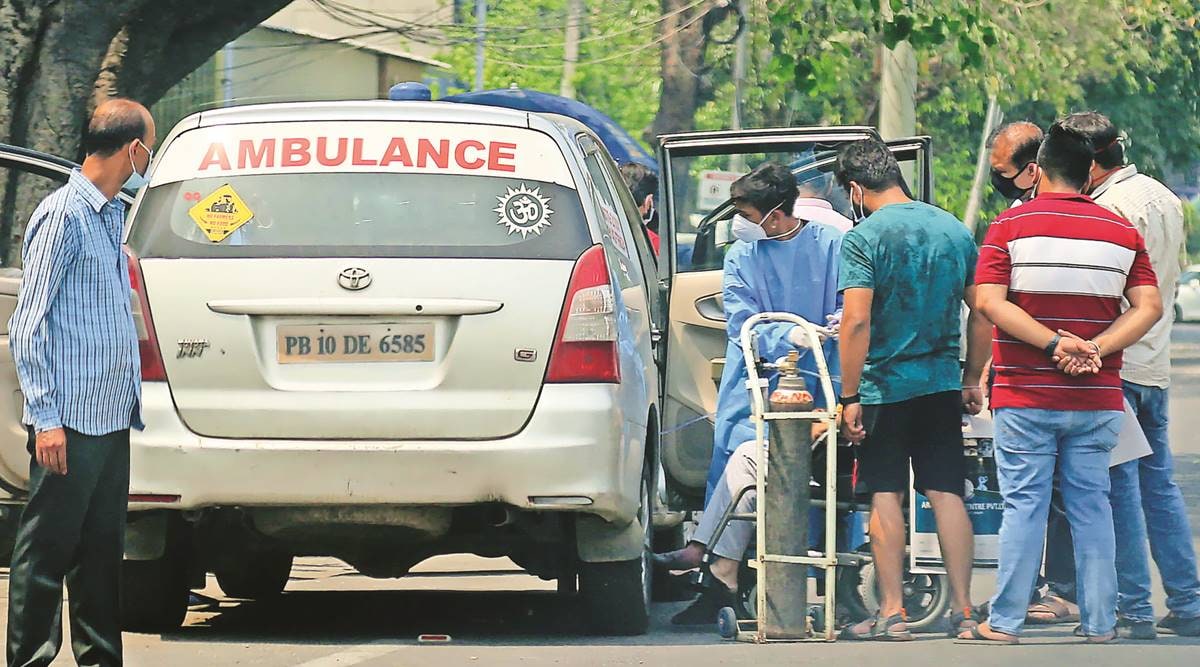 A patient is shifted to a hospital in Ludhiana on Sunday. (Express Photo by Gurmeet Singh)
A patient is shifted to a hospital in Ludhiana on Sunday. (Express Photo by Gurmeet Singh) The third phase (for people in the 18-44 age group) of the Covid vaccination drive in government hospitals/health centres of Punjab is set to begin from Monday, along with the inoculation drive for construction workers across the state.
VK Janjua, principal secretary, department of labor, Punjab said that currently the state has 2.94 lakh valid registered construction workers of which 2.19 lakh were in the 18-44 age group. “In the first round, the priority is to vaccinate 2,19,630 registered construction workers aged 18-44 years. Later, we will also try to cover their family members, who are around 5.19 lakh in number. The labour department staff will coordinate with the health department to get registered construction workers vaccinated,” said Janjua.
“Though the total registered construction workers in Punjab are around 3.76 lakh, some have not renewed their registrations. So, the current valid registrations are 2.94 lakh. Nearly 4000 workers are above the age of 60 years,” he said.
The phase-3 of Covid vaccination drive was launched nationally on May 1, but Punjab failed to start its inoculation of people in the 18-44 age group as it was still waiting for delivery of its first batch of Covishield doses from Serum Institute of India (SII). Punjab placed an order for 30 lakh doses of which 1 lakh have been received and 3.29 lakh more doses are expected to be delivered later this May. As per the Centre’s new vaccination policy that came into effect from May 1, the Government of India will continue to supply vaccines to states free of cost for 45+ beneficiaries, health care and frontline workers. But for population in the age group of 18-44 , the state governments and private hospitals have to buy vaccines on their own from manufacturing companies.
Keeping in view the total population, number of active cases, density, mortality rate and other factors, Ludhiana district has been allocated the maximum vaccine doses from the first batch of 1 lakh Covishield doses for 18-44 age group. As per district-wise allocation, Ludhiana has been allocated 16,818 doses, followed by Amritsar (10,036), Gurdaspur (8,801), Jalandhar (8,583), Hoshiarpur (6,310), Patiala (5,591), Sangrur (5,465), Kapurthala (5,355), Faridkot (3,790), Bathinda (3,508), Pathankot (3,413) and SBS Nagar (2,332).
Barnala, Fazilka, Ferozepur, Fatehgarh Sahib, Mansa, Moga, Muktsar, Ropar, Sangrur and Tarn Taran have been allocated 2,000 doses each.
Hussan Lal, principal secretary, health, said that for the month of May, the state was expecting a delivery of 3.29 lakh more doses from SII for the 18-44 age group. “SII has committed to a total delivery of 4.29 lakh doses this month, against our order of 30 lakh doses. For 45+ population, 1.63 lakh doses are coming from the Centre,” said Lal. “The labour department staff will coordinate with health department for vaccination of construction workers from Monday. We are covering building and other construction workers in the first round as they are high risk group with maximum chances of getting infected,” he said.
Meanwhile, in a statement, Punjab health minister Balbir Singh Sidhu said that the Vaccine Expert Committee has recommended that increased doses be sought in partnership with private sector and other sources. Individuals with co-morbidities are at highest risk of severe disease and hence 70 percent of doses are allocated to this group in the next phase.
The Health Minister informed that the list of co-morbidities is as specified previously by the Government of India, but should be extended to include obesity (BMI>30), disabilities (for example, spinal cord injury) and multiple co-morbidities determined to increase the risk by a treating physician.
Pointing out the high-risk groups in certain populations, he said that certain professions have greater interactions with other individuals and are at highest risk of infection and transmission, and hence 30 per cent of doses are allocated to this group. A list of professions at risk has already been presented in the strategy, but for May 2021, only the top three categories will be included — government employees, construction workers, teachers and other staff at government and private educational establishments.
Highlighting the strategy used for allocating the vaccines to the districts, he said that districts have been ranked based on population-based incidence, mortality and density into 3 zones — A, B and C — in order of priority, according to which they have been allocated 50 per cent, 30 per cent and 20 per cent of doses.
Within these zones, the expert committee recommends that vaccination be limited to major urban centres, while vaccine supplies are severely constrained and allocation has been made proportionate to the population of major urban areas of Zones A and B. For Zone C, they recommend an equal distribution of doses across each district. When further doses are available or as the epidemiologic situation changes, the prioritization framework may be modified.
- The Indian Express website has been rated GREEN for its credibility and trustworthiness by Newsguard, a global service that rates news sources for their journalistic standards.

